Idaho is a state known for agriculture, Yellowstone National Park, forests, and waterfalls. It is home to more than 400 species of birds, which means bird watchers will never get bored in Idaho! You can check out our Idaho Bird Guide for more information about some of these species.
The landscape in Idaho gives birds access to many different habitats. North American sparrows can be found in saltmarshes, deserts, mountains, and cities, which is part of why they are such widespread birds.
There are 19 kinds of sparrows that spend the winter, the summer, or all year in Idaho. Let’s learn about what makes each one unique.
What Makes a Sparrow a Sparrow?
Sparrows are often called “little brown jobs,” or LBJs, because they are such plain little birds. At a closer glance, though, you can see the many differences from one kind of bird to another.
Most sparrows are small, between 5 and 7 inches long. Towhees, Buntings, and Larks are also part of the Passeridae family, and they are excellent at camouflage. They have short, sharp bills that are good for cracking into nuts and seeds.
The appearance of their wings, tail, and body shape will vary from one species to the next. You’ll notice that sparrows that forage in muddy waters have long, strong legs, whereas desert-dwelling sparrows have lighter, smaller legs.
Because sparrows do look so much alike, it can be a really fun challenge to learn to identify the differences between each type.
How Many Sparrows Are in Idaho?
Our list covers 19 kinds of sparrows.
Sometimes, a rare migratory vagrant will make its way into Idaho, but we are only including the species that you have a substantive chance of seeing in Idaho every year.
Some are more rare than others, but all of them are consistently found in Idaho.
To make the list as easy to use as possible, we are dividing the sparrows into three lists: sparrows that are here all year, sparrows that are only here in the summer, and sparrows that are only here in the winter. Interestingly, there are no sparrows that consistently migrate through Idaho.
Learning to Identify Sparrows
Identifying sparrows is a challenge, sure, but it’s not an impossibility!
Birders can learn to distinguish between the 19 sparrows on our list by paying close attention to the bird’s appearance, behavior, and location.
If you see a sparrow in the wild, try to get a good picture and record any sounds it is making. If you can’t do that, take notes on these questions — that way, you can come back later and figure out which bird you encountered.
- What color is the bird’s face, chest, nape, belly, flanks, tail, and wings?
- What kinds of patterns, streaks, patches, etc are on the bird’s body?
- Are there any facial markings, such as eyerings, stripes, mustaches, a cap, etc?
- What is the bird’s shape?
- What part of Idaho were you in when you saw this sparrow?
- What kind of habitat was the bird in?
- What time of year did you see the bird?
- Was the sparrow doing anything unusual when you saw it? Such as hiding, scurrying on the ground, perching to sing, diving at other birds, eating, etc?)
- What was the bird eating?
This is the kind of information you will need to figure out what kind of sparrow you have seen. Some additional good news is that these questions can also help you identify other birds, too.
Sparrows in Idaho Year-Round
There are 5 kinds of sparrows that live in Idaho year-round. They are the Dark-Eyed Junco, the House Sparrow, the Song Sparrow, the Spotted Towhee, and the White-Crowned Sparrow.
These birds may stay in the same area all year, or they may migrate a small distance that is still within Idaho.
Dark-Eyed Junco
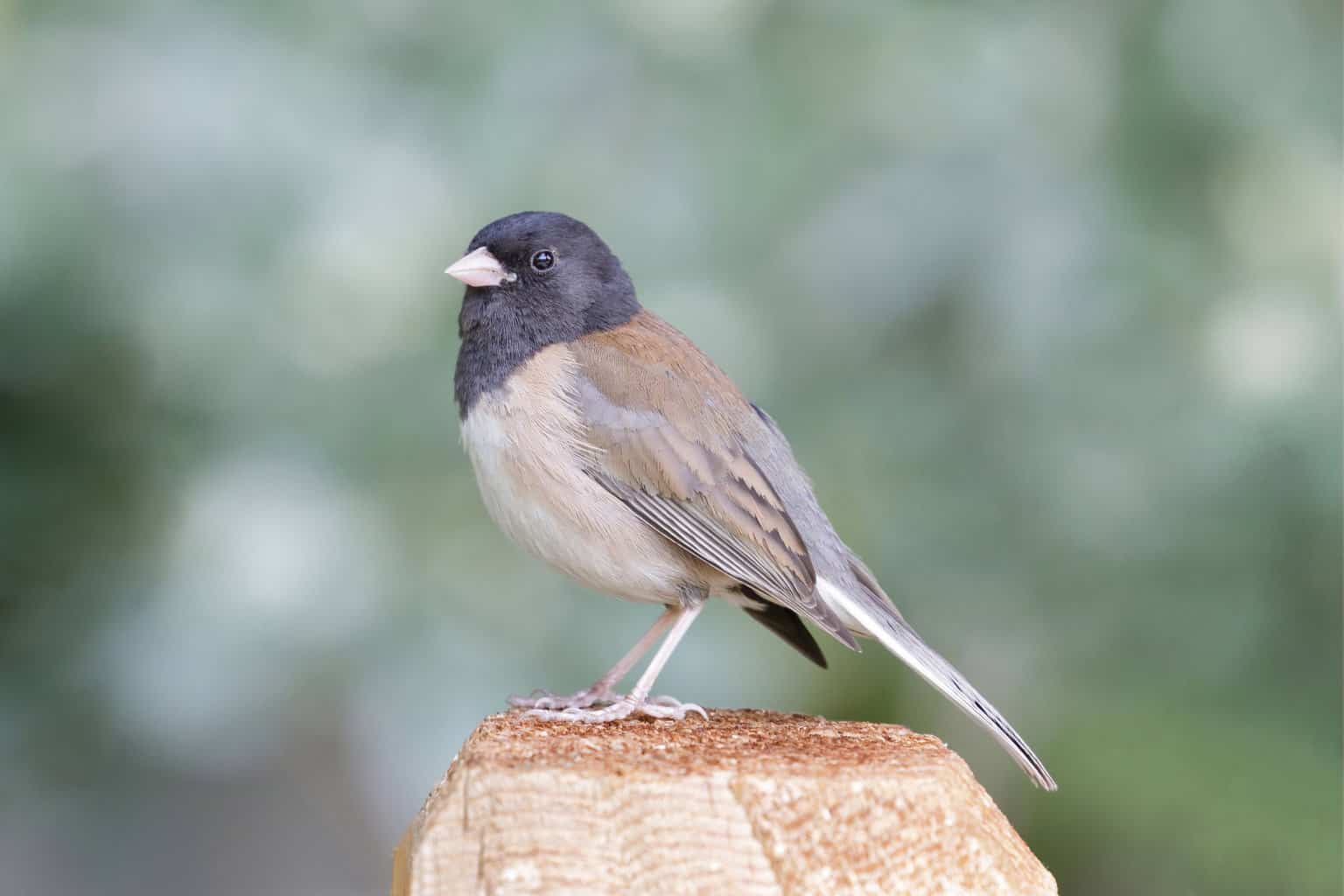
- Junco hyemalis
- ORDER: Passeriformes
- FAMILY: Passerellidae
- Length: 5.5-6.3 in (14-16 cm)
- Weight: 0.6-1.1 oz (18-30 g)
- Wingspan: 7.1-9.8 in (18-25 cm)
Dark-Eyed Juncos are among the most common birds in North America.
They are often associated with the arrival of winter, as they are seen so frequently at backyard bird feeders in the wintertime throughout most of the US. They are sometimes called “snowbirds” because of this.
In Idaho, they are year-round residents of the entire state. They are comfortable with a variety of winter and summer habitats, including coniferous forests, parks, woods, backyards, and fields. They will thrive at sea level and up to 11,000 feet above it.
They are gray-headed, with a dark gray back and wings, too. Their bellies are whiteish-to-light gray. They have pink bills.
House Sparrow

- Passer domesticus
- ORDER: Passeriformes
- FAMILY: Passeridae
- Length: 5.9-6.7 in (15-17 cm)
- Weight: 0.9-1.1 oz (27-30 g)
- Wingspan: 7.5-9.8 in (19-25 cm)
House Sparrows are an invasive species that is common throughout all of North America. They live in Idaho year-round, and you are most likely to find them in cities, towns, and near barns and buildings. They are a problem for native species because they are aggressive little birds who outcompete other birds for territory and food.
The male House Sparrow has a mostly gray head with a rufous crown, white cheeks, and a black bib. The female is mostly brown with black stripes on her wings and back.
Many sparrows avoid people, but House Sparrows prefer to live alongside humans. They live in the rafters of barns and in the eaves of houses.
Song Sparrow

- Melospiza melodia
- ORDER: Passeriformes
- FAMILY: Passerellidae
- Length: 4.7-6.7 in (12-17 cm)
- Weight: 0.4-1.9 oz (12-53 g)
- Wingspan: 7.1-9.4 in (18-24 cm)
Song Sparrows have a lot of regional variation in their appearance, but all of them have brown bodies and white chest streaking. The amount of streaking on their bodies is dependent upon the different genetic groups that have emerged in each region. For example, Song Sparrows from the desert tend to be lighter in color than coastal Song Sparrows.
Song Sparrows are year-round residents of Idaho. They usually return to the exact same nesting ground as they used the previous year. That means that if you see a nesting Song Sparrow one summer, you will probably see her again the next year and the year after that!
Song Sparrows nest nearby one another, usually on the ground but occasionally up to 15 feet into a tree or bush. They nest near water and don’t mind human activity whatsoever. Like House Sparrows, you will often find Song Sparrow nests where there are plenty of people, such as a house or a landscaping bed.
Spotted Towhee
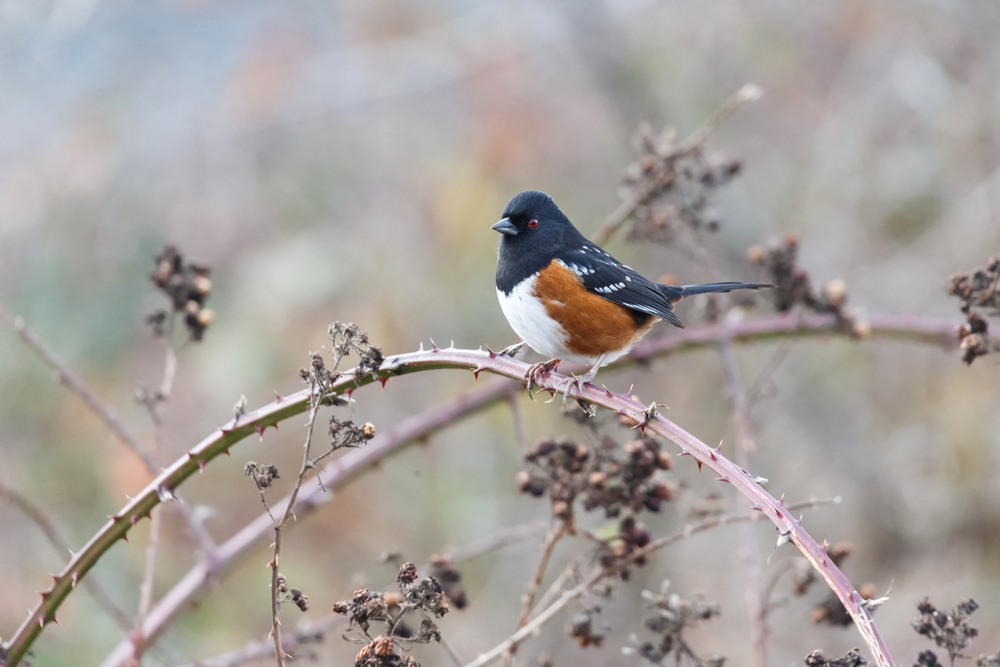
- Pipilo maculatus
- ORDER: Passeriformes
- FAMILY: Passerellidae
- Length: 6.7-8.3 in (17-21 cm)
- Weight: 1.2-1.7 oz (33-49 g)
- Wingspan: 11.0 in (28 cm)
Towhees tend to be larger than other sparrows, and that is definitely the case with the Spotted Towhee. When you see this bird at a feeder, it will be easy to spot because of its size in addition to its coloring.
The male Spotted Towhee is tri-colored: his throat, head, and wings are black, his belly is white, and his sides are rufous.
The female looks almost identical, except she has dark brown coloring instead of black.
Both sexes have white spots on their wings, setting them apart from the Eastern Towhee. (Note that you won’t have to differentiate these two birds in Idaho; Eastern Towhees do not live here.)
Spotted Towhees live year-round in Idaho’s Southwest and Magic Valley regions. They are summer residents of the rest of the state. Their nest is an open cup-style nest made of grasses, twigs, and even animal hair.
In the summer, they eat a lot of insects: wasps, bees, moths, weevils, beetles, ladybugs, grasshoppers, caterpillars, etc.
In the winter, as insects become less available, their diet transitions to being mostly plant and seed-based. That includes chickweed, cherries, oats, corn, blackberries, poison oak, sumac, thistles, and raspberries.
White-Crowned Sparrow

- Zonotrichia leucophrys
- ORDER: Passeriformes
- FAMILY: Passerellidae
- Length: 5.9-6.3 in (15-16 cm)
- Weight: 0.9-1.0 oz (25-28 g)
- Wingspan: 8.3-9.4 in (21-24 cm)
The White-Crowned Sparrow has a grayish-brown body and a dramatically striped head that is black and white. It has a pink or yellow bill. Before they mature, juveniles have brown and white stripes, not black and white ones.
During the breeding season, they nest in shrubby fields and right along the edge of the forests. They like to have access to both uncovered, unprotected ground and well-protected grassy patches so that they can forage in the open but retreat quickly to safety.
White-Crowned Sparrows are “double-scratchers.” It’s a pretty cute little feeding habit, in which they hop back and forth as they look for food. A quick hop back will flip over a leaf, and then a quick hop forward allows them to snatch up their prey.
Whether or not you will see White-Crowned Sparrows in Idaho is dependent upon when you are there and where you are in the state.
In the summer, you can find them in the Bitterroot Mountains. In the winter, they live along the Snake River Plain. They are also found year-round in the Sawtooth Range and along the southern border of the state.
Sparrows in Idaho in the Summer
Most sparrows that live in Idaho are summer-only visitors. There are 13 kinds of sparrows that live here during the summer: the Black-Throated Sparrow, the Brewer’s Sparrow, the Chipping Sparrow, the Clay-Colored Sparrow, the Fox Sparrow, the Grasshopper Sparrow, the Green-Tailed Towhee, the Lark Bunting, the Lark Sparrow, the Sagebrush Sparrow, the Savannah Sparrow, and the Vesper Sparrow.
Black-Throated Sparrow
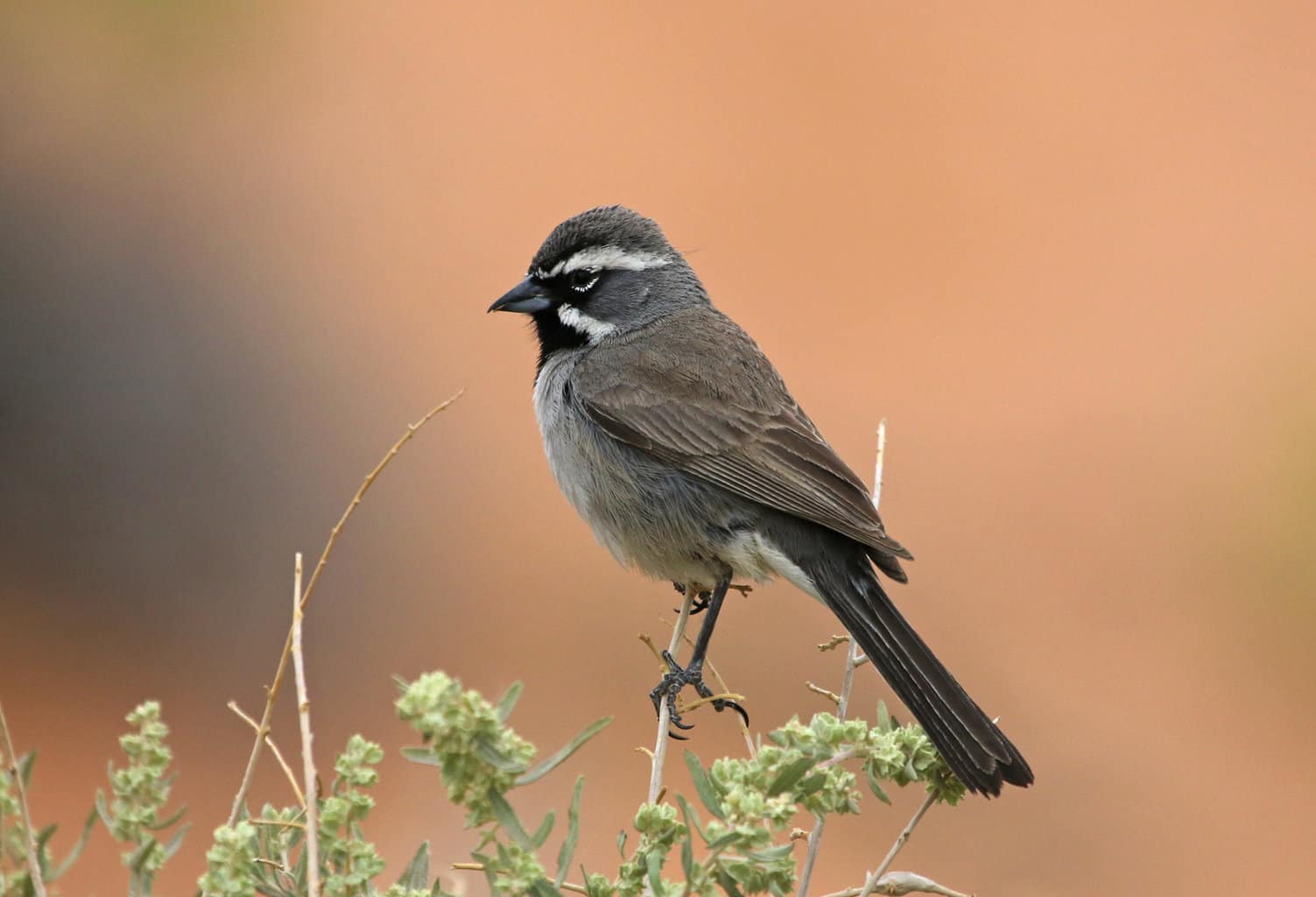
- Amphispiza bilineata
- ORDER: Passeriformes
- FAMILY: Passerellidae
- Length: 4.7-5.5 in (12-14 cm)
- Weight: 0.4-0.5 oz (11-15 g)
- Wingspan: 7.7 in (19.5 cm)
Black-Throated Sparrows are grayish-brown with round heads and white-edged dark tails. Their facial coloring makes them easy to spot. On the bird’s gray face are two bold white stripes and a black “eyebrow” marking above the eyes.
You can also identify them by the black patchy-looking triangle on their throat.
You won’t find Black-Throated Sparrows in most of Idaho, but there are some summer residents along the southern border of the state in the Southwest, Magic Valley, and Southeast areas.
Their summer habitat consists of areas with lots of short, scattered trees. Desert washes and canyons are great, and they do well in areas with the following bushes and trees: rabbitbrush, chollas, mesquite, sagebrush, acacia, creosote, and ocotillo.
Even with this presence in lowlands, they also inhabit altitudes as high as 7,000 feet above sea level.
Brewer’s Sparrow
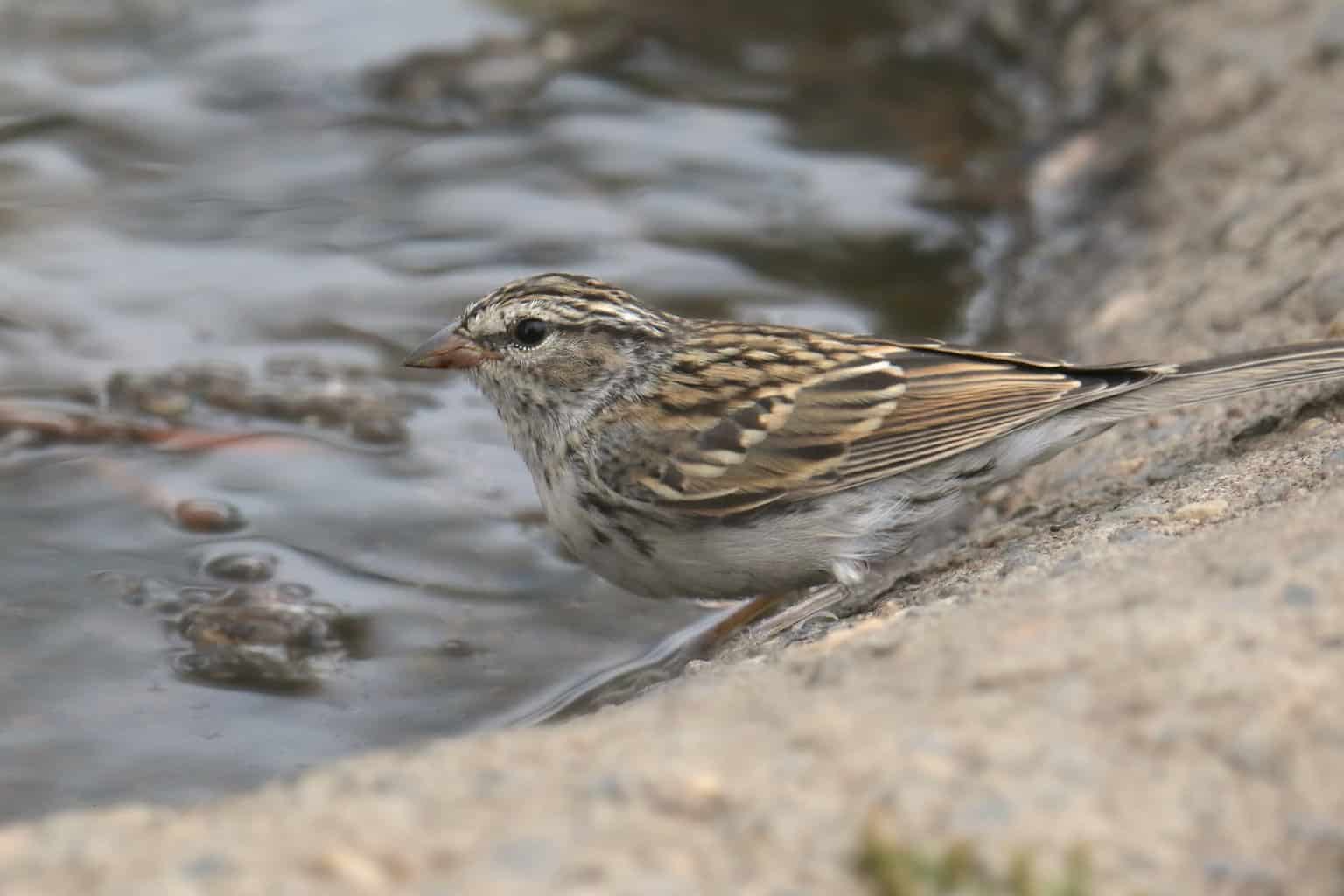
- Spizella breweri
- ORDER: Passeriform
- FAMILY: Passerellidae
- Length: 5.1-5.9 in (13-15 cm)
- Weight: 0.4-0.5 oz (11-14 g)
- Wingspan: 7.1-7.9 in (18-20 cm)
Brewer’s Sparrows are not only the smallest sparrows, but they are also some of the plainest birds in North America. Sometimes they are called “the bird without a field mark” because their coloring is so muted and simple.
They are grayish-brown, with some brown streaking on their back and neck. They have a notched tail, rounded wings, and white eyering with a gray stripe above the eyes.
They are only found in the western half of North America. They are late-spring migrants to their summer breeding ground, and then they depart again in early fall. They are the most abundant bird in the interior West of the US.
Listen for a long, trilling song during the breeding season, as they are usually hiding in protective brush and grasses.
They are found throughout Idaho during the summer.
Chipping Sparrow
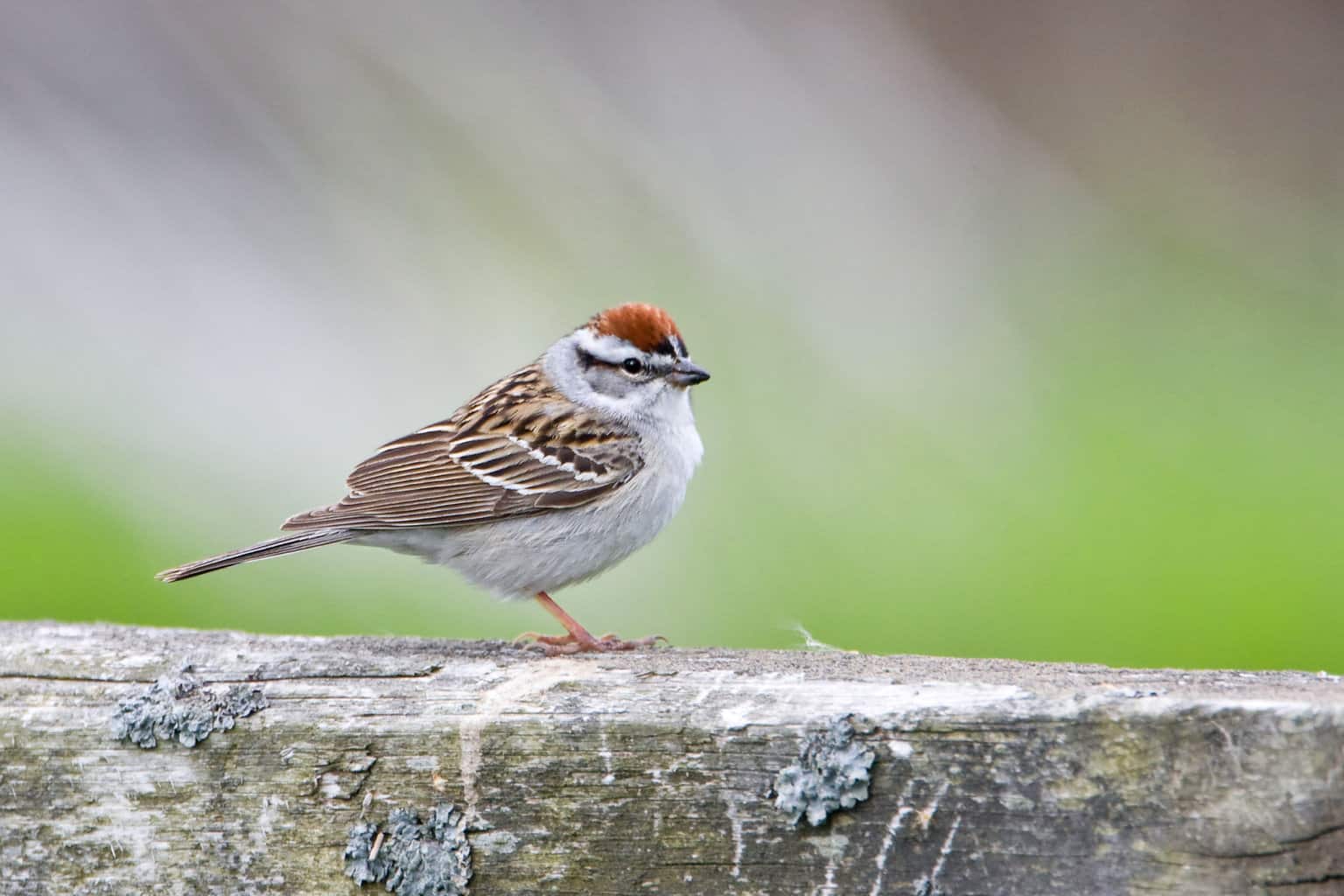
- Spizella passerina
- ORDER: Passeriformes
- FAMILY: Passerellidae
- Length: 4.7-5.9 in (12-15 cm)
- Weight: 0.4-0.6 oz (11-16 g
- Wingspan: 8.3 in (21 cm)
Chipping Sparrows are incredibly widespread. Their summer breeding range stretches from the west coast to the east coast, from northern Canada to Mexico. During the winter, they move to a relatively small range, which includes Florida, Mexico, and the Caribbean.
Male Chipping Sparrows have black eye stripes, a rufous cap, and dark streaking on their wings and back. Females are darker in color.
They live all summer in Idaho, eating bugs and insects like leafhoppers, grasshoppers, beetles, and caterpillars – as well as some spiders.
Their nest is similar to other sparrows: cup-shaped and built on the ground out of leaves, stems, twigs, roots, and weeds.
Clay-Colored Sparrow
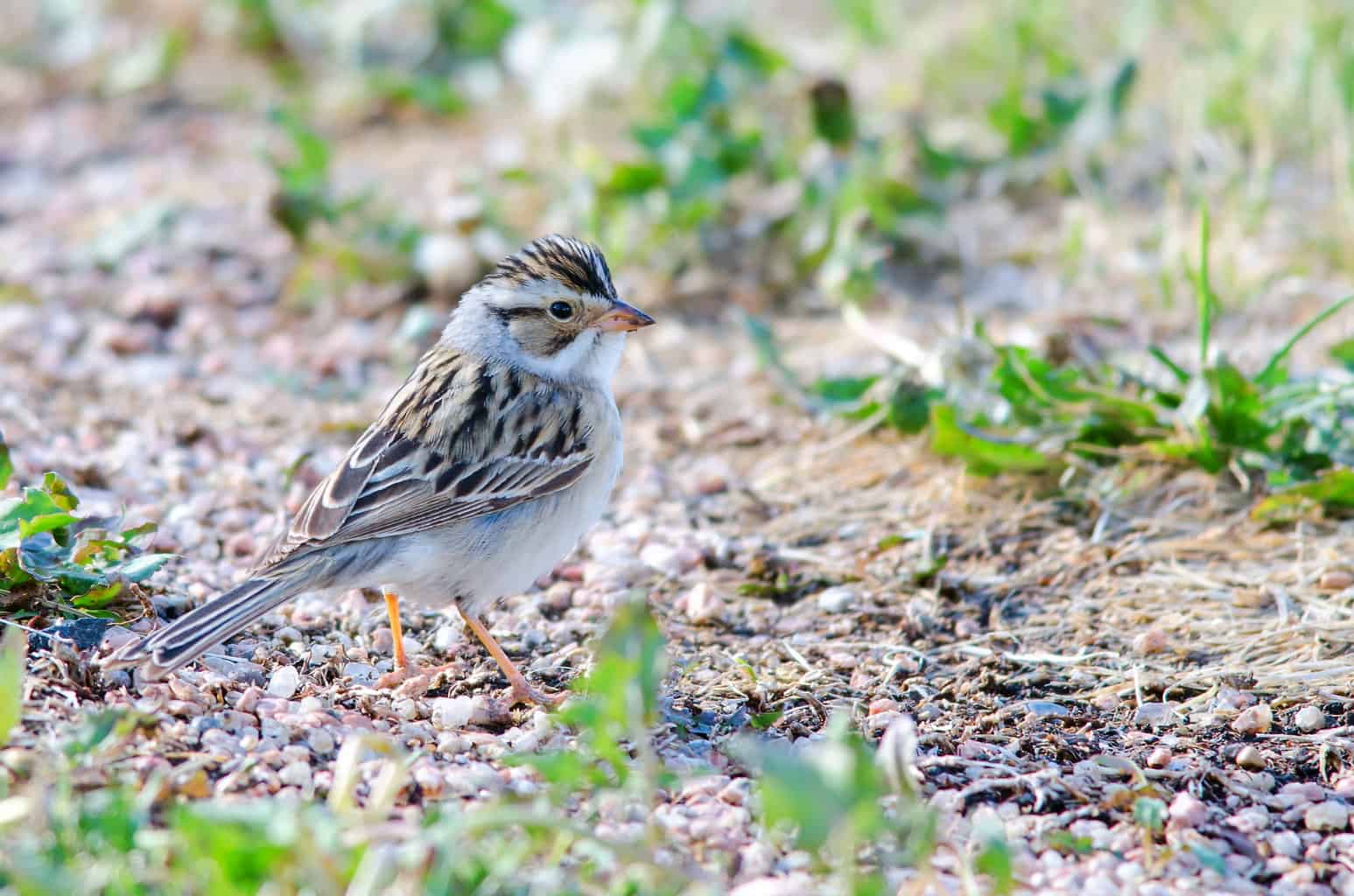
- Spizella pallida
- ORDER: Passeriformes
- FAMILY: Passerellidae
- Length: 5.1–6 in (130–150 mm)
- Weight: 12 g (0.42 oz)
- Wingspan: 7.5 in (190 mm)
The Clay-Colored Sparrow is mostly pale tan and gray with a gray collar around the neck and thin streaks on their heads. Their cheeks are slightly darker than the rest of the face.
They breed in shrubby woodlands and along the edges of fields, as well as prairie thickets. They live in conifer trees during the summer, which is why they are often found at Christmas tree farms.
Clay-Colored Sparrows are pretty rare in Idaho, as their summer territory just barely extends into a tiny part of the state: the Selway-Bitterroot Wilderness.
Fox Sparrow

- Passerella iliaca
- ORDER: Passeriformes
- FAMILY: Passerellidae
- Length: 5.9-7.5 in (15-19 cm)
- Weight: 0.9-1.6 oz (26-44 g)
- Wingspan: 10.5-11.4 in (26.7-29 cm)
Fox Sparrows vary from region to region. They are either gray or red, depending on how much red streaking is on their body. Look for brown chest spots to identify them.
Although Fox Sparrows are native to North America, individuals have been found in far-flung places like Iceland, Italy, Greenland, and Germany. They likely got there by hopping a ride on a ship!
They are large sparrows who are known for making a mess as they kick leaf litter around, foraging. They are common at backyard feeders and can be found all summer long in Idaho. They are widespread throughout the state.
Grasshopper Sparrow
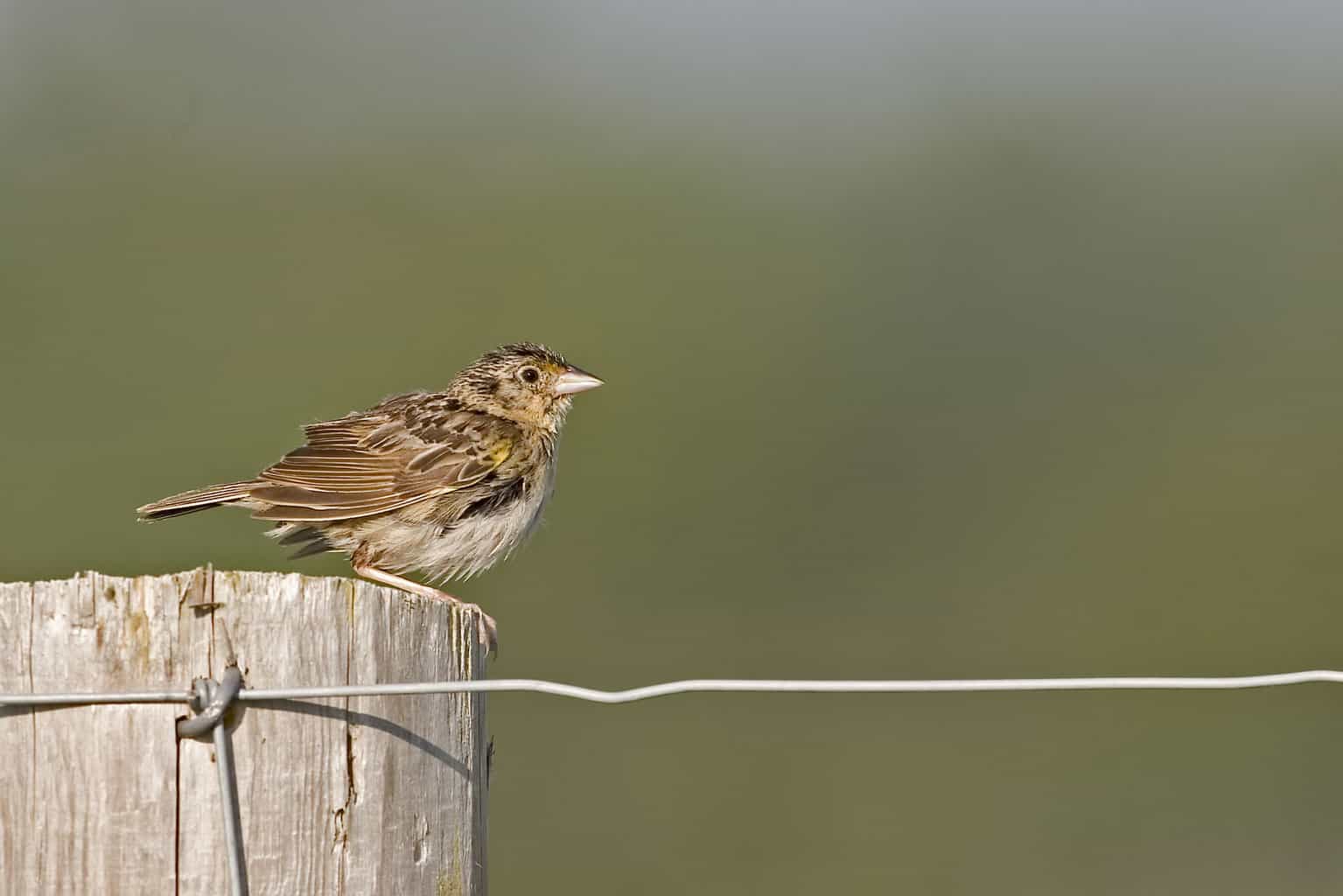
- Ammodramus savannarum
- ORDER: Passeriformes
- FAMILY: Passerellidae
- Length: 4.3-4.5 in (10.8-11.5 cm)
- Weight: 0.5-0.7 oz (14-20 g)
- Wingspan: 7.9 in (20 cm)
Grasshopper Sparrows eat grasshoppers – but that’s not where they get their name. After all, lots of sparrows eat grasshoppers as part of their insect-based summer diet.
No, Grasshopper Sparrows get their name from their vocalizations, which sound like a loud, buzzy grasshopper. Males also have a squeaky, melodic song, making them one of the only sparrows with two different songs.
Grasshopper Sparrows have a muted appearance, ranging from tan or gray to light orange. Their necks are thick and their heads are somewhat flattened. They have stubby tails and large bills.
Unlike sparrows which are almost always hiding under bushes and shrubs, Grasshopper Sparrows are frequently found out in the open, including perched on barbed wire fences.
They aren’t widespread in Idaho; instead, they are found only in a strip of territory along the southern border with Utah and Nevada. They are summer-only residents of this region. In the winter, they move into the southeastern US and Mexico.
Green-Tailed Towhee
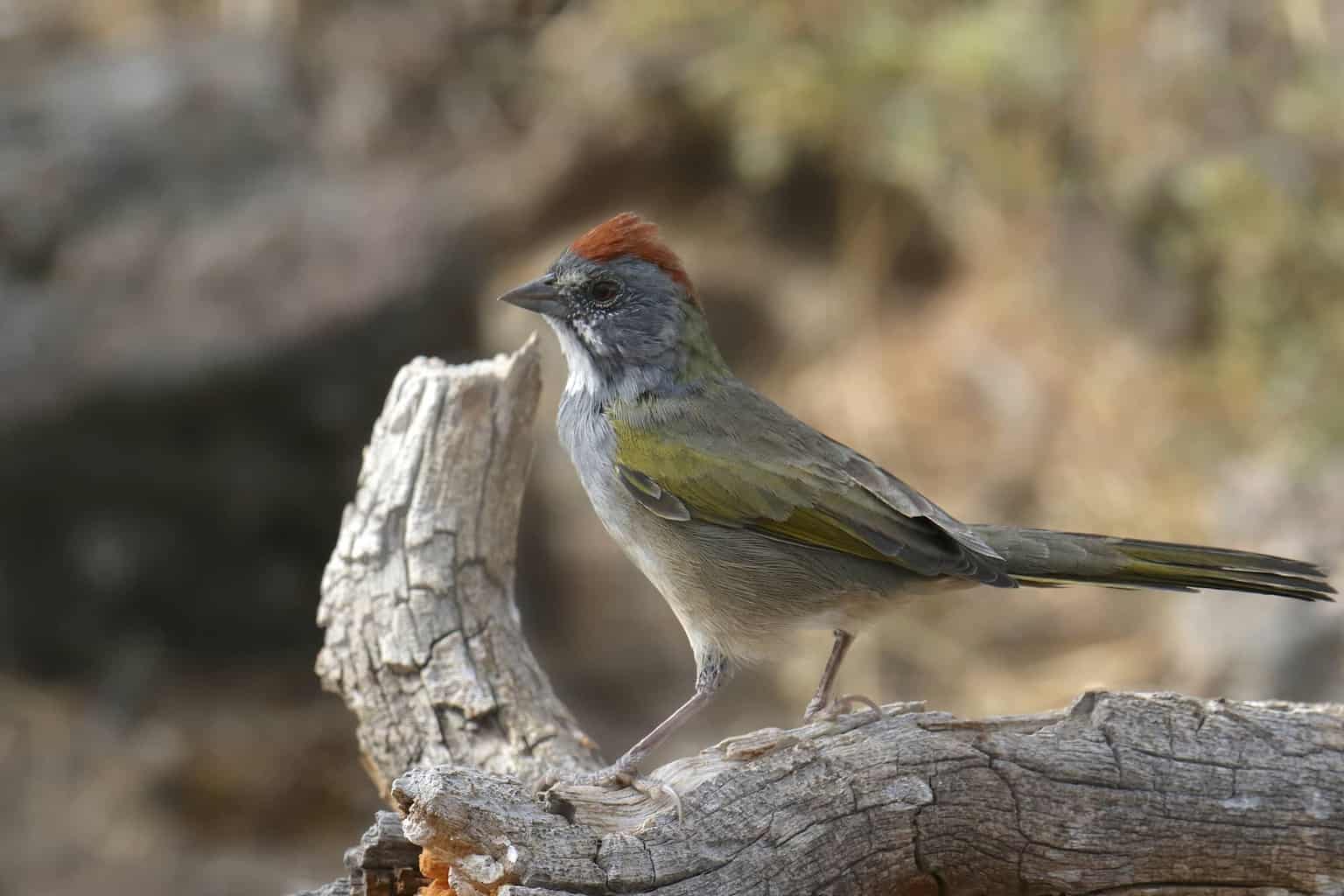
- Pipilo chlorurus
- ORDER: Passeriformes
- FAMILY: Passerellidae
- Length: 8.3-9.8 inches (21–25 cm)
- Weight: 1.3-2.4 oz (37-67 g)
- Wingspan: 11.4 inches (29 cm)
In my opinion, the Green-Tailed Towhee is the prettiest sparrow in Idaho.
Green-Tailed Towhees are large (like other Towhees), and they have a slate gray body with a gorgeous green wash on their wings and tails. Adding contrast, they also have a rufous crown, a white throat, and a dark mustache stripe on their face.
They are found in the summer in southern Idaho. They don’t nest very far north of the Snake River. Look for their nests on the ground or settled into a shrub, such as sagebrush. Their nests are big and deep, shaped like a cup, and made of loosely-woven twigs, weeds, grasses, leaves, and strips of bark. They line their nest with fine grasses and animal hair.
Lark Bunting

- Calamospiza melanocorys
- ORDER: Passeriformes
- FAMILY: Passerellidae
- Length: 5.5-7.1 in (14-18 cm)
- Weight: 1.3-1.5 oz (35.3-41.3 g)
- Wingspan: 9.8-11.0 in (25-28 cm)
Male Lark Buntings have a different appearance in the summer vs. the winter. During the breeding season, they are dark black with white patches on their wings. Then, in the winter, they are streaky and brown, with leftover white on their upper wings.
Females are always streaked in brown. Both sexes have a thick, blue-gray bill.
Lark Buntings are not common enough in Idaho for the state to be included on most range maps, but the Idaho Department of Fish & Game has documented a number of observations in southeastern Idaho – only during the summer.
They prefer shrubs and cacti for their summer habitat, and they nest at the base of these plants.
Lark Sparrow
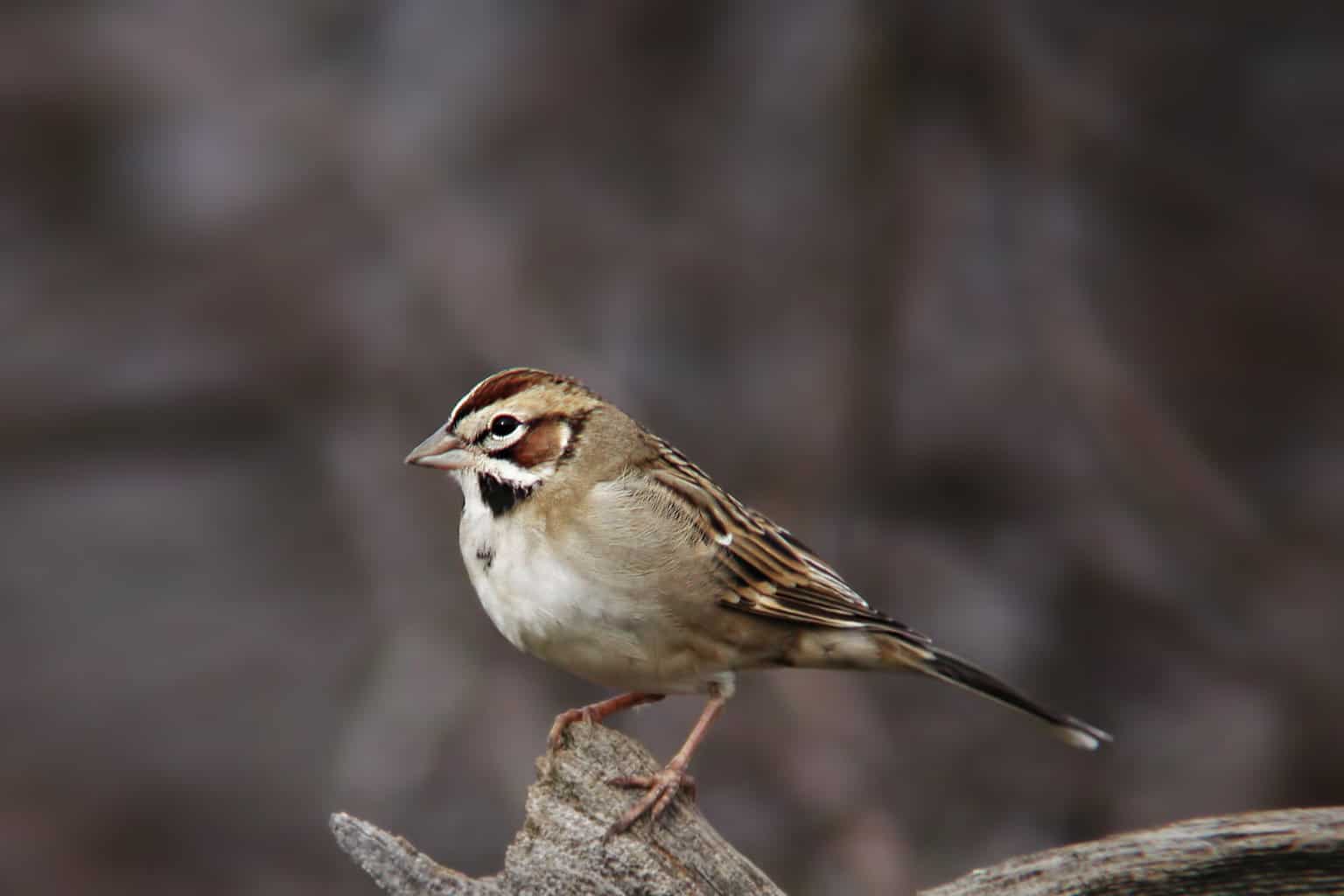
- Chondestes grammacus
- ORDER: Passeriformes
- FAMILY: Passerellidae
- Length: 5.9-6.7 in (15-17 cm)
- Weight: 0.8-1.2 oz (24-33 g)
- Wingspan: 11.0 in (28 cm)
Lark Sparrows have bulky gray bodies, long tails with rounded feathers, and a brown striped face. They also have a black chest patch that should help you distinguish them from other similarly-patterned birds.
They are a species of low concern, even though they have been experiencing a population decline. There are an estimated 11 million Lark Sparrows globally, with the vast majority of those birds in North America.
This population decline has been accompanied by a reduction in their total range area. They used to spend the summer as far as the East Coast, but today they only breed as far east as central Ohio.
Lark Sparrows forage on the ground for insects in the summer and seeds in the winter.
There is a small population in the Magic Valley area that are year-round residents. If you imagine a U-shape around the edges of Idaho, you’ll have a good idea of their summer breeding range. They don’t really visit the panhandle or central Idaho.
Lincoln’s Sparrow

- Melospiza lincolnii
- ORDER: Passeriformes
- FAMILY: Passerellidae
- Length: 5.1-5.9 in (13-15 cm)
- Weight: 0.6-0.7 oz (17-19 g)
- Wingspan: 7.5-8.7 in (19-22 cm)
For the most part, Lincoln’s Sparrows lack distinctive markings on their bodies. They are brown and gray with stripes, and their tail and wings are tipped with brown. They have white bellies and a pale “mustache” on their face. Their brown crown has a gray stripe right down the middle.
Lincoln’s Sparrows spend the summer in northern Idaho. Specifically, they can be found all year in the Panhandle and Clearwater regions. In the rest of the state, you will only find them during their migration windows.
In the spring, their migration occurs between late March and May. In the fall, they begin migrating in September.
Lincoln’s Sparrows are solitary birds during the winter. In the summertime and during migration, you’ll find them in groups of other sparrows, including Song Sparrows and White-Crowned Sparrows. In other states, they are also found with Swamp Sparrows.
Sagebrush Sparrow
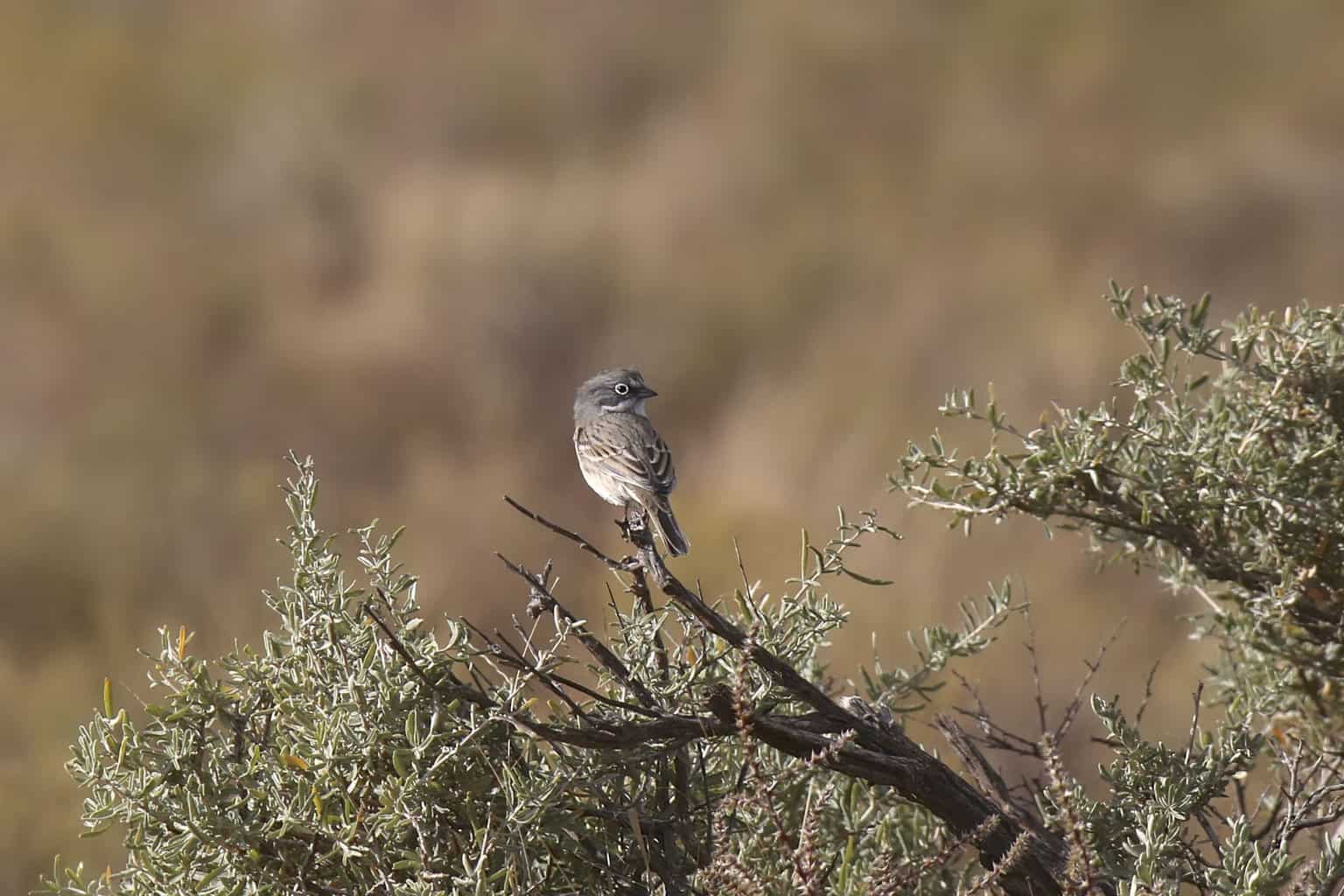
- Artemisiospiza nevadensis
- ORDER: Passeriformes
- FAMILY: Passerellidae
- Length: 4.7-5.9 in (12 – 15 cm)
- Weight: 0.5-.08 oz (15-22 g)
- Wingspan: 8.25 in (20.95 cm)
The Sagebrush Sparrow has a long dark tail, a rounded head, and a short, thick bill. Its coloring is brown, and it has a white spot in front of its eyes, white eyerings, and a dark throat stripe.
Their name comes from the fact that they thrive in sagebrush-rich habitats. They are summer residents of southern Idaho, especially on the west and east sides. There are fewer of them in the Snake Valley Plain.
They spend a lot of time hiding in the shrubby bushes, except for in the spring and summer, when males perch out in the open and sing.
One of their adaptive traits is to interbreed with other sparrows, which means you will often encounter hybrid species in areas where there are lots of Sagebrush Sparrows.
Savannah Sparrow
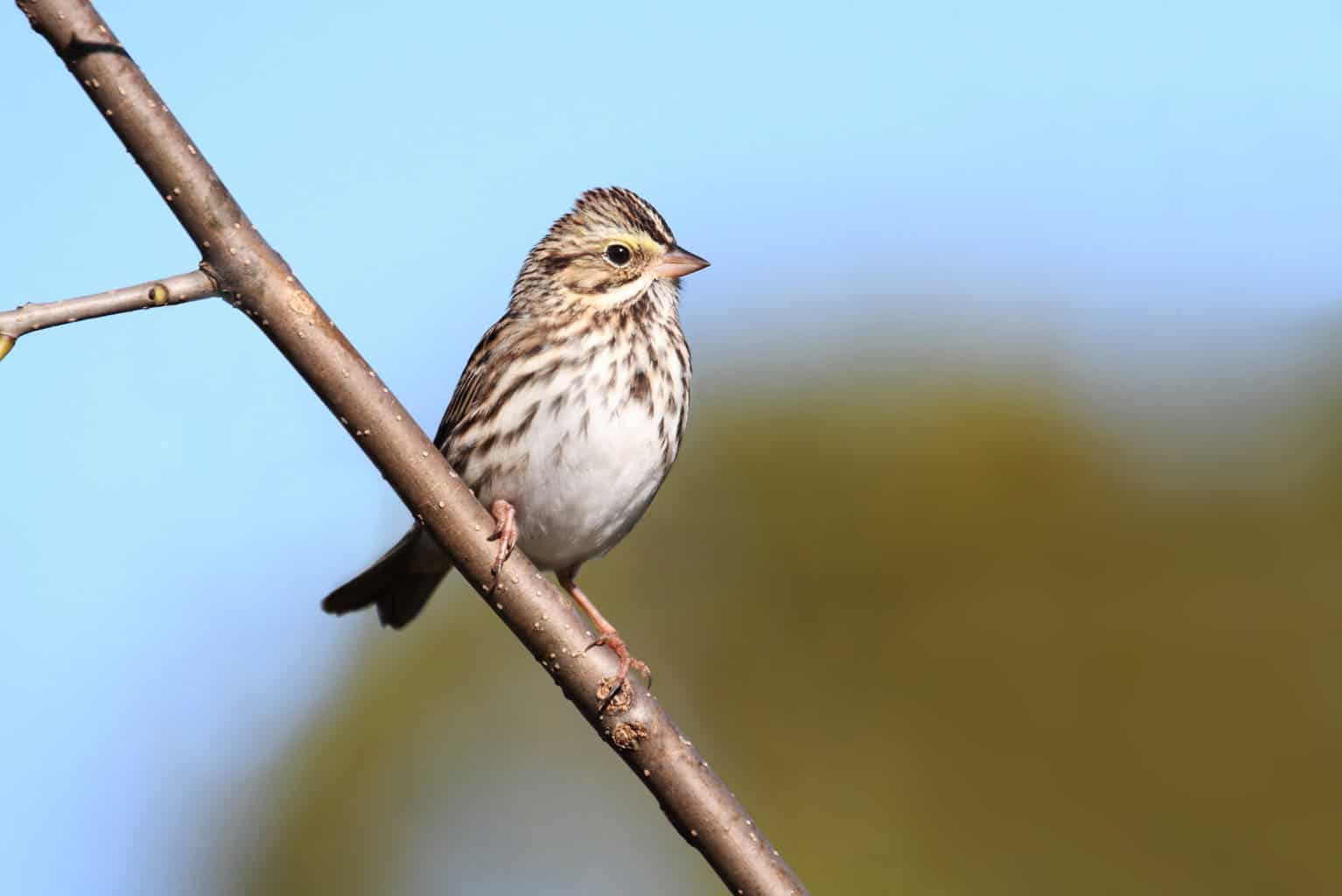
- Passerculus sandwichensis
- ORDER: Passeriformes
- FAMILY: Passerellidae
- Length: 4.3-5.9 in (11-15 cm)
- Weight: 0.5-1.0 oz (15-28 g)
- Wingspan: 7.9-8.7 in (20-22 cm)
The Savannah Sparrow has a distinctive yellow patch between its eyes and bill, making it quite easy to spot. Additionally, these sparrows have dark streaks on their backs and wings. They have sharp bills.
During the breeding season, they are widespread throughout much of the US and Canada. They live across all of Idaho during the summer, especially in grassy areas. They prefer meadows, pastures, and even grassy patches along Idaho’s roadways. They also visit cover-crop fields, such as Alfalfa, which is grown here in Idaho.
Vesper Sparrow

- Pooecetes gramineus
- ORDER: Passeriformes
- FAMILY: Passerellidae
- Length: 5.1-6.3 in (13-16 cm)
- Weight: 0.7-1.0 oz (20-28 g)
- Wingspan: 9.4 in (24 cm)
The last sparrow in our summer-only list for Idaho is the Vesper Sparrow.
This is one of North America’s largest sparrows. Vesper Sparrows have chestnut-brown patches on their shoulders, white eyerings around their eyes, and brown streaking on their body.
They are named for the fact that they sing a lovely song at dusk, which is when the Vesper prayer service is held in many Christian traditions. Listen out for their melody as the sun sets.
Vesper Sparrows are found throughout Idaho in the summer. They are ground nesters, usually finding a place to build their nest in the tall grasses or right beside a fallen tree or branch.
Sparrows in Idaho in the Winter
Only one kind of sparrow is a winter-only resident of Idaho: the American Tree Sparrow.
American Tree Sparrow
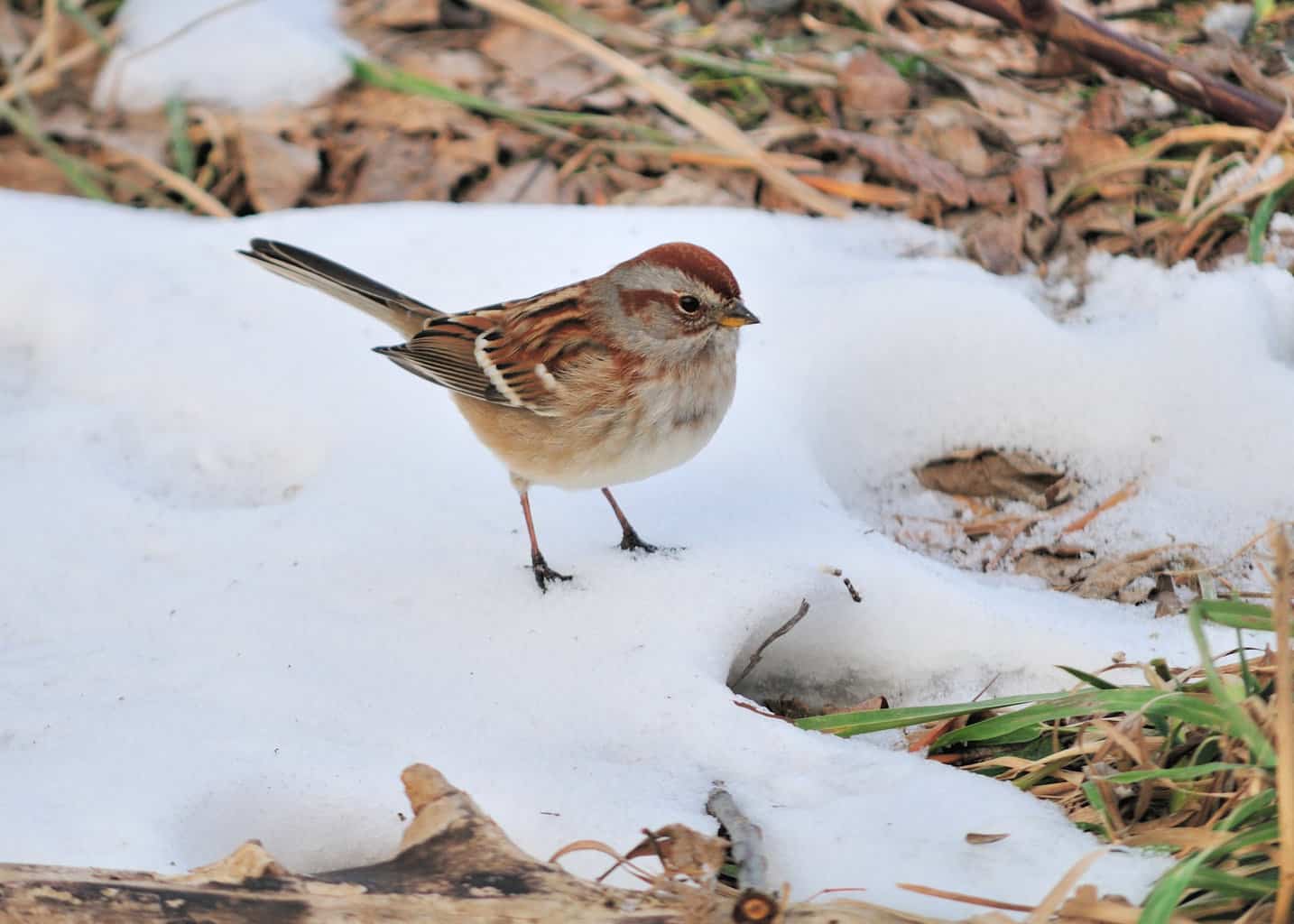
- Spizelloides arborea
- ORDER: Passeriformes
- FAMILY: Passerellidae
- Length: 5.5 in (14 cm)
- Weight: 0.5-1.0 oz (13-28 g)
- Wingspan: 9.4 in (24 cm)
Some American Tree Sparrows have a red breast patch that helps them stand out from other sparrows in the area. They have gray, striped wings and a reddish-brown crown.
American Tree Sparrows breed in northern Canada, across the tundra. Their winter range covers most of the US, including all of Idaho.
They migrate long distances, and yet their winter and summer habitats are quite similar. These birds have consistent preferences! They want open land that is near woods, water, and plenty of weeds for cover and for food.
Finding Sparrows in Idaho
We hope you’re ready to go out and find some sparrows in Idaho!
Whether you live in the state year-round or are just visiting, it’s clear that there are plenty of birds to see here. Many of those birds are sparrows. These Little Brown Jobs, as it turns out, are each unique from one another!
Although it’s a challenge to learn to differentiate between them, it can definitely be done. Don’t forget to check out our Idaho Bird Guide for more information about more fascinating birds in Idaho!

